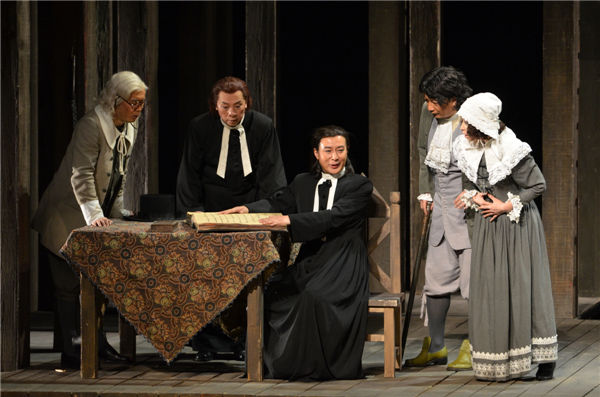 |
|
Director Wang Xiaoying revived the Chinese version of Arthur Miller's play The Crucible in Beijing. [Photo provided to China Daily] |
The Crucible had such a faithful revival that not only was the cast pretty much the same as that of a decade ago-the last time it was presented in China-but one has a feeling that a significant portion of the audience were repeat attendees.
During the Jan 14 performance, the rounds of applause were timed so accurately that they seemed to come from a popular opera with old-chestnut arias.
Wang Xiaoying's staging of the Arthur Miller play opened in 2002, which was the inaugural show for the National Theater of China. The company was formed by combining China Youth Art Theater and Central Experimental Theater. Although the witch hunt of 1692 was by no means familiar to members of the Chinese public, it had been drummed home that Miller wrote it as an allegory of McCarthyism and the blacklisting of accused Communists in the US.
To any experienced theatergoer in China, or anyone steeped in the culture of innuendos and suggestions, the parallels with China's own recent past would not be lost. The scenes where Salem residents, all pious believers in God, were forced to accuse fellow townsfolk of siding with the Devil are powerful reminders of how far human nature would deviate from its origin of good intentions, and how difficult it is to maintain independence of thinking in the midst of a religion-or ideology-driven mania.
Wang's production pays lip service to period authenticity while succeeding spectacularly at bringing out the message. The hollowed-out wooden structure functions as a metaphor for prison. Ropes for hanging, accompanied by ominous music, serve as a constant visual motif for the penalty for integrity and holding onto truth. A giant mask is placed where the chandelier is for The Phantom of the Opera, right above the orchestra seat.
Subtlety is not a forte for this production. Actors invariably speak at the top of their lungs and act with exaggerated movements, which was the generally accepted idea of how Westerners express themselves before pirated undubbed movies flowed into China and showed that naturalism is the norm of acting in Western countries.
Anachronistic details abound. For someone who cannot tell a Puritan of colonial America from a Protestant or a Catholic, symbol-rich Catholicism stands in for everything Christian. You'd be much better off if you don't know the sources of the music, which comes from medieval chanting of European monks, the strikingly pagan thumping from The Rite of Spring and, in the case of the native American slave girl Tituba, a folk song eerily similar to the style of some Yunnan-based ethnic minority.
I don't think most Chinese would mind these foibles. But the fact that actresses who play Abigail and the other young girls are old enough to play their mothers is a major distraction and takes a lot of getting used to.
This version of The Crucible ran at the National Center for the Performing Arts from Jan 14 to 18. In a post-show speech, Wang said Miller must be watching from heaven. I'd be interested to know what he makes of the local equivalents of what happened in Salem 300-plus years ago.
|
|
|
|
|
|
|
|
